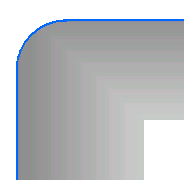 | ||||||||||||||||||
 |  |
| RuBPS Staining - RuBPS - RuBPS FAQs | |
|
FAQs about RuBPS From one unit RuBPS is sufficient to prepare 3 litres of staining solution. 3 L of staining solution is enough to stain 15 large (24cm) 2D-gels or 60 small SDS gels. The staining of one gel comes roughly to CHF 1.—(70 Eurocent or 0.85$). This means that RuBPS from RubiLAB is about 20 times cheaper than comparable dyes see detailed list on this website. RuBPS has absolutely no competitor concerning the costs. .
3. What are the shipping costs? We sell the only dye and not water! Shipping milligrams of dye is much cheaper than shipping tons of water as most our competitors do. So it easy to understand that shipping milligrams of dye saves your time and your money! So the shipping costs a as low as: CHF 20.-- (14 Euro, 17$). .
4. Are there discounts? Yes. If you need large quantities of RuBPS we will find a special price for you. 5. What is the stability of RuBPS? RuBPS from RubiLAB is sold as solid powder. In this physical form RuBPS is rock stable for years without cooling. As soon as it is dissolved to 20 mM, RuBPS is stable at least for 5 Years is stored in a dark bottle at 4°C (normal fridge). .
6. How long does it take to stain a gel with RuBPS The staining of one gel with RuBPS will take about 1 hour. So it is as fast as CBB staining but much more sensitive with a much broader linear dynamic range. 7. Is RuBPS compatible with MS? Yes it is. It is equal to CBB but has a 4-times increased sensitivity and a much broader linear dynamic range. .
8. Is RuBPS compatible with blotting procedures? Yes it is. We sell you a dye for gel- and blott-staining. Just stain your gel with RuBPS, scan it, and then do the transfer to the membrane (nitrocellulose or PVDF). Scan the membrane, and you receive a copy of your gel on the membrane. RuBPS does not interfere with the immunodetection! So you can detect all protein spots in the gel and on the membrane copy and specifically label your target protein at once! No other dye can do this. For the same purpose our competitors will sell you two staining solutions, which mainly contain water, at a 40 times higher price. As solutions are heavy they cause high shipping costs and take you a lot of space for storage. There is no need to buy two dyes to stain membranes and gels, but our competitors simply think:"why only sell one, if you could sell two for the double price?".
9. Is RuBPS a copy of SYPRO Ruby? The answer is no. There were always rumours that RuBPS is a copy of SYPRO Ruby, but as it is well known, it is not. The rumour originally came from the Rabilloud article in 2000 where he started these speculations. This rumour was boosted when RuBPS was called “Fluka-SYPRO” by some speakers at the Proteomic Forum 2003 in 10. What is the meaning of RuBPS? RuBPS is the short form of Ruthenium (II) tris (bathophenantroline disulfonate) also termed as Ruthenium (II) tris (4,7-diphenyl-1,10-phenantrolin disulfonate). 11. What is RuBPS? RuBPS is the transition metal complex Ruthenium (II) tris (4,7-diphenyl-1,10-phenantrolin disulfonate). 12. Who invented RuBPS? RuBPS was first synthesized as a precursor molecule for a dye used as a non-radioactive label for oligo nucleotides by Prof. Willi Bannwarth ( . 13. Who developed the staining techniques? Prof. Thierry Rabilloud introduced RuBPS as a fluorescent label for protein detection in polyacrylamide gels. Rabilloud T, Strub JM, Luche S, Girardet JL, van Dorsselaer A, Lunardi J: Ruthenium II tris (bathophenanthroline disulfonate), a powerful fluorescent stain for detection of proteins in gel with minimal interference in subsequent mass spectrometry analysis. Proteome 2000;1:1-13 His initial staining technique was further developed during 6 years in our Lab and published here: Lamanda A, Zahn A, Roder D, Langen H: Improved Ruthenium II tris (bathophenantroline disulfonate) staining and destaining protocol for a better signal-to-background ratio and improved baseline resolution. Proteomics 2004;4:599-608 and here: Lamanda A, Cheaib Z, Turgut MD: Protein buffering in model systems and in whole human saliva. PLoS ONE 2007; Feb 28;2(2):e263. The Methods were first licenced to Sigma-Aldrich and later commercialised by RubiLAB. 14. How popular is the RuBPS staining method? The RuBPS staining method has been cited in more than 60 scientific articles from plant proteomics to brain research and was taken up as method in 4 Books, was subject to research in 5 PhD thesis and has found its way into wikipedia and arxive. The RuBPS staining method has won the 1st price for R&D in 2002 (DC Bank Avard, Switzerland) and the Wrigley Prophylaxe Avard in Germany for R&D in 2006.
Kostenlose Website erstellt mit Web-Gear Verantwortlich für den Inhalt dieser Seite ist ausschließlich der Autor dieser Webseite. Verstoß anzeigen | |